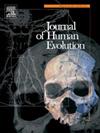人类踝关节复合体在不平坦地形上行走的适应功能及其对人类运动的影响
IF 3.1
1区 地球科学
Q1 ANTHROPOLOGY
引用次数: 0
摘要
古人类是在多种多样的自然环境中进化的,这些自然环境带来了不同的生物力学挑战,包括凹凸不平的表面,这些表面会影响两足行走时的平衡控制。先前的实验研究已经确定了一种维持平衡的“脚踝策略”,其中人类踝关节复合体(AJC;距下关节和距踝关节用于帮助将脚置于身体下方。然而,踝关节策略在不平坦地面行走中的作用目前尚不清楚,阐明这一作用可以帮助我们理解人类AJC的进化及其在自然地形上两足行走时的潜在适应功能。在这里,我们收集了17名参与者的三维运动学、动力学和肌电图数据,他们赤脚行走在平坦、平坦的表面上,以及在由乙烯-醋酸乙烯泡沫分层块组成的不平坦表面上,重复0.8-2.4厘米的高度变化。我们建立了线性混合效应模型,将参与者身份作为随机效应,将步行表面条件作为固定效应。采用3型方差分析来评估不同地表条件下的差异。在不平坦的表面上,参与者在站立阶段的前半段平均AJC正面运动范围和关节力矩分别增加38%和28% (p <;0.001),并且在单肢支持时,腓骨长肌和胫骨前肌之间有更大的共激活(p <;0.02)。这些结果表明,AJC的移动性对于在不平坦的表面上保持平衡至关重要,因此,古人类可能经历了选择压力,以保持一些更适应树栖的祖先的关节顺应性。然而,这种保持灵活性的代价是易受关节损伤的影响,这意味着古人类在自然地形上行走时必须依靠长腓骨等肌肉来稳定脚踝。本文章由计算机程序翻译,如有差异,请以英文原文为准。
The adaptive function of the human ankle joint complex during walking on uneven terrains with implications for hominin locomotion
Hominins evolved in a vast diversity of natural environments with terrains that pose different biomechanical challenges, including uneven surfaces that can impact balance control during bipedal walking. Previous experimental research has identified an ‘ankle strategy’ for maintaining balance, wherein motion at the human ankle joint complex (AJC; the subtalar and talocrural joints) is used to help position the foot under the body. However, the role of the ankle strategy during uneven surface walking is currently unknown, and elucidating this role could help us understand the evolution of the hominin AJC and its potential adaptive function in bipedal walking on natural terrains. Here, we collected three-dimensional kinematic, kinetic, and electromyographic data from 17 human participants who walked barefoot on a flat, even surface and on an uneven surface consisting of tiered blocks of ethylene-vinyl acetate foam, with a repeating 0.8–2.4 cm height variation. We developed linear mixed-effect models, incorporating participant identity as a random effect and walking surface condition as a fixed effect. Type 3 analyses of variance were employed to evaluate differences across surface conditions. On the uneven surface, participants averaged 38% and 28% greater AJC frontal plane ranges of motion and joint moments, respectively, during the first half of the stance phase (p < 0.001) and had greater coactivation between the fibularis longus and tibialis anterior muscles during single-limb support (p < 0.02). These results suggest that AJC mobility is critical for balance on uneven surfaces, and therefore, hominins may have experienced selective pressure to maintain some of the joint compliance of more arboreally adapted ancestors. However, this retained mobility comes with the trade-off of susceptibility to joint injury, meaning that hominins must rely on muscles like the fibularis longus to stabilize the ankle when walking on natural terrains.
求助全文
通过发布文献求助,成功后即可免费获取论文全文。
去求助
来源期刊

Journal of Human Evolution
生物-进化生物学
CiteScore
6.30
自引率
15.60%
发文量
104
审稿时长
3 months
期刊介绍:
The Journal of Human Evolution concentrates on publishing the highest quality papers covering all aspects of human evolution. The central focus is aimed jointly at paleoanthropological work, covering human and primate fossils, and at comparative studies of living species, including both morphological and molecular evidence. These include descriptions of new discoveries, interpretative analyses of new and previously described material, and assessments of the phylogeny and paleobiology of primate species. Submissions should address issues and questions of broad interest in paleoanthropology.
 求助内容:
求助内容: 应助结果提醒方式:
应助结果提醒方式:


